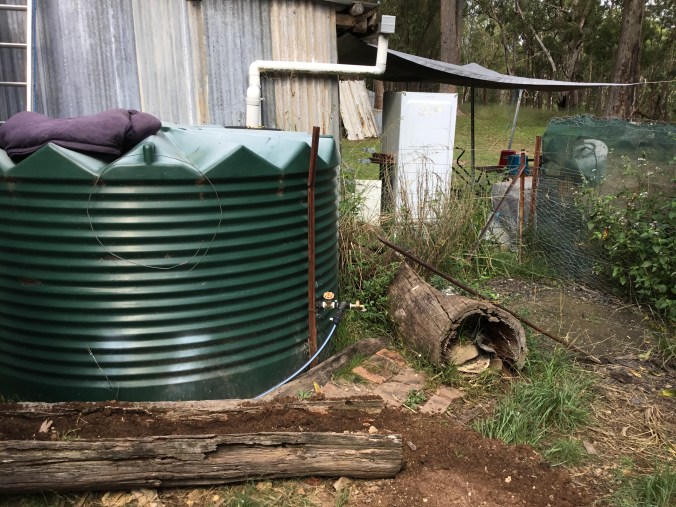The photo below may not seem like much, but it is a HUGE leap forward for us. Please excuse the finger in the shot, I was in a hurry to get back to filling the trench. This photo represents a change in our water harvesting and disposal system.
Previously, our waste water from the kitchen ran out of the humpy into a trench in the soil and was allowed to spread out randomly from there. You can see the big clump of iris and weeds against the wall of the humpy which marks the start of the previous trench. This system created a mess of muddy trench and water sitting on the surface of the soil. I put in a lot of work, with help from family and friends, to dig a drain trench and put in some actual plumbing. While I was at it, I dug a trench for the effluent from the biogas unit too. This effluent previously went to a transpiration pit near the unit, but I wanted to extend the pit, so decided to plumb all our kitchen and biogas overflow into a banana circle.
What is a banana circle? It is a hole with bananas and other useful plants growing around the edge. Banana circles usually have a water source and the centre is used as a compost pile. This provides nutrients and water to the hungry crops and makes a little island of fertility.

Below you can see the beginning of my banana circle. The plumbing is in and I have dug a hole about a metre deep in the centre and piled the soil up around the edge. My circle is in a low place in the yard, so it will also channel rain water into it. Because it is being used as a transpiration pit, I was careful to dig the hole deep enough to (hopefully) prevent overflow during rain events.

I piled logs and sticks into the hole to provide something to soak up all that water and nutrient and hold it in dry times. I also added a layer of compost over the trench to give the bananas a fighting chance. I edged the piles with big pieces of branch to make an edge to mow against and to hold in the compost and mulch.

I planted my banana suckers (only two so far), some cassava cuttings and about 100 comfrey roots. Then I started to trim and weed the garden and pile up the centre of my circle. I will continue to pile up cuttings and garden scraps in the middle of the circle. The water in the pit should be covered by material at all times, so it will be a race to keep enough composting material in there as it breaks down (it might encourage me to weed more).

This little project has solved a problem (sloppy trench through the yard) and provided a place to grow food and medicine (bananas, cassava and comfrey). It also used up one pile of sticks and wood from the sheep paddock that needed to be cleared. I am very satisfied with my results on this project.





























![20180106_172252[1]](https://i0.wp.com/chroniclesofahumpydweller.com/wp-content/uploads/2018/01/20180106_1722521.jpg?resize=676%2C507&ssl=1)
![20180107_102222[1]](https://i0.wp.com/chroniclesofahumpydweller.com/wp-content/uploads/2018/01/20180107_1022221.jpg?resize=676%2C507&ssl=1)
![20180107_102316[1]](https://i0.wp.com/chroniclesofahumpydweller.com/wp-content/uploads/2018/01/20180107_1023161.jpg?resize=676%2C507&ssl=1)
![20180107_102625[1]](https://i0.wp.com/chroniclesofahumpydweller.com/wp-content/uploads/2018/01/20180107_1026251.jpg?resize=676%2C507&ssl=1)
![20180106_172449[1]](https://i0.wp.com/chroniclesofahumpydweller.com/wp-content/uploads/2018/01/20180106_1724491.jpg?resize=676%2C507&ssl=1)
![20180107_102400[1] 20180107_102400[1]](https://i0.wp.com/chroniclesofahumpydweller.com/wp-content/uploads/2018/01/20180107_1024001.jpg?w=447&h=335&ssl=1)
![20180107_102358[1] 20180107_102358[1]](https://i0.wp.com/chroniclesofahumpydweller.com/wp-content/uploads/2018/01/20180107_1023581.jpg?w=221&h=166&ssl=1)
![20180107_102352[1] 20180107_102352[1]](https://i0.wp.com/chroniclesofahumpydweller.com/wp-content/uploads/2018/01/20180107_1023521.jpg?w=221&h=165&ssl=1)
![20180107_102644[1] 20180107_102644[1]](https://i0.wp.com/chroniclesofahumpydweller.com/wp-content/uploads/2018/01/20180107_1026441.jpg?w=672&h=504&ssl=1)
![20171221_082429[1]](https://i0.wp.com/chroniclesofahumpydweller.com/wp-content/uploads/2017/12/20171221_0824291.jpg?resize=676%2C507&ssl=1)
![20171221_082504[1]](https://i0.wp.com/chroniclesofahumpydweller.com/wp-content/uploads/2017/12/20171221_0825041.jpg?resize=676%2C507&ssl=1)
![20171221_082441[1]](https://i0.wp.com/chroniclesofahumpydweller.com/wp-content/uploads/2017/12/20171221_0824411.jpg?resize=676%2C507&ssl=1)
![20171221_082445[1]](https://i0.wp.com/chroniclesofahumpydweller.com/wp-content/uploads/2017/12/20171221_0824451.jpg?resize=676%2C507&ssl=1)
![20171221_082458[1]](https://i0.wp.com/chroniclesofahumpydweller.com/wp-content/uploads/2017/12/20171221_0824581.jpg?resize=676%2C507&ssl=1)
![20171221_082500[1]](https://i0.wp.com/chroniclesofahumpydweller.com/wp-content/uploads/2017/12/20171221_0825001.jpg?resize=676%2C507&ssl=1)
![20171221_082512[1]](https://i0.wp.com/chroniclesofahumpydweller.com/wp-content/uploads/2017/12/20171221_0825121.jpg?resize=676%2C507&ssl=1)
![20171221_082501[1]](https://i0.wp.com/chroniclesofahumpydweller.com/wp-content/uploads/2017/12/20171221_0825011.jpg?resize=676%2C507&ssl=1)
![20171223_092954[1]](https://i0.wp.com/chroniclesofahumpydweller.com/wp-content/uploads/2017/12/20171223_0929541.jpg?resize=676%2C507&ssl=1)
![20171223_092913[1]](https://i0.wp.com/chroniclesofahumpydweller.com/wp-content/uploads/2017/12/20171223_0929131.jpg?resize=676%2C507&ssl=1)





























